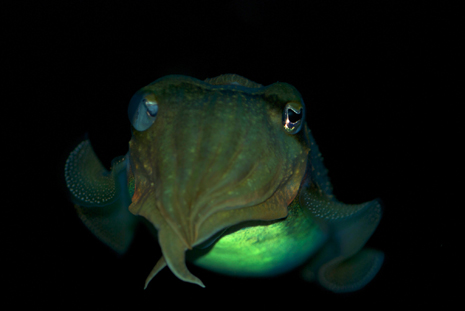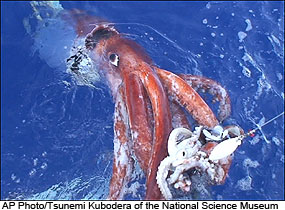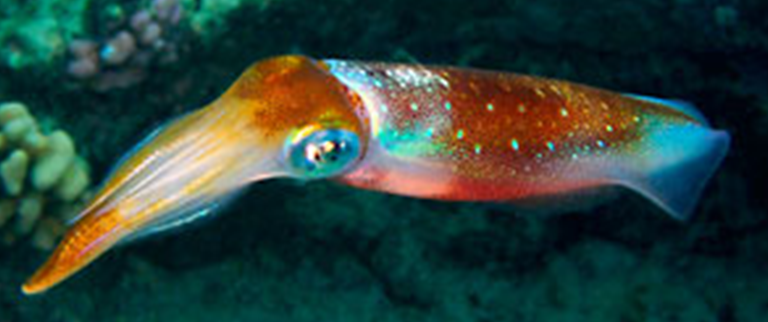Sepioteuthis lessoniana frequently get mistaken for being cuttlefish. Cuttlefish, have
 a gas
filled structure which allows them to remain buoyant. The main
part of the body is called a mantle which has attached to it eight arms
and two feeding tentacles. Like the Bigfin Reef Squid, Cuttlefish have
chromatophores which gives the organism the ability to change its
appearance in color and texture.
a gas
filled structure which allows them to remain buoyant. The main
part of the body is called a mantle which has attached to it eight arms
and two feeding tentacles. Like the Bigfin Reef Squid, Cuttlefish have
chromatophores which gives the organism the ability to change its
appearance in color and texture.The three closest related squid species are Loligo bleekeri, Loligo edulis and Todarodes pacificus. They are also used in commercial food industries. This is especially common in Coastal regions of warm tropical waters.
There are a variety of different species that live amongst the Sepioteuthis lessoniana.
There are countless varieties of bacteria and protozoa that inhabit the same warm oceanic waters as the Sepioteuthis lessoniana. There are also countless numbers of Fungi.Under the Plantea Kingdom, there are so many organisms that contribute to the habitat of the Sepioteuthis lessoniana. To name a few of these organisms are Allocasasuarina littoralis (common in Melbourne, Australia), Schoenus calostachyus (common in Chinese waters) and Acacia leptocarpa (a weed found in shallow waters).
A water-wading bird that is commonly found in the temperate zone along with the Bigfin Reef Squid is Esacus neglectus which is found along the northern shores of Australia.
Within the chordate Phyla, there are mostly bony fish that surround the environment such as Pentapodus paradiseus (Whiptail) , Abalistes stellatus (Starry Trigger Fish), and Epibulus insidiator (Slingjaw wrasse).
Within the Arthpropods there are organisms such as Melicertus latisulcatus (Blue-Leg western King Prawn), Portunus pelaicus (flower crab) and Ibacus peronii (Slipper Lobster).
.png) Some other molluscs that live in similar environments as
Sepioteuthis lessoniana are
Globivenus
toreuma (clam) and Phyllidia coelestis (Sea Slug).
Some other molluscs that live in similar environments as
Sepioteuthis lessoniana are
Globivenus
toreuma (clam) and Phyllidia coelestis (Sea Slug).
Some non-fish chordates are Megaptera novaeangliae (Humpback Whale) and the Lutjanus sebae (Emporer Red Snapper).
For more information on other species please visit multipleorganisms.net
Other interesting organisms already a part of multipleorganisms.net:
* The Great White Shark (Carcharodon carcharias) - The Great White Shark are found throughout temperate, coastal waters worldwide. They are endangered species because humans use their meat as food and sell their teeth for money.
* Japanese Pufferfish (Takifugu rubripes) - The Japanese puffer fish is a delicacy in Japan. Even though if prepared wrong, can cause death, the prices on these marine animals are sky high.
* Sea Cucumber (Parastischopus californicus)- Sea Cucumbers are invertebrates which reside in marine habitats. These creatures have the unique ability to regenerate parts of their body that become detached.
* Portugueses Man Of War (Physalia physalis) - The Portuguese Man of War are found throughout tropical and subtropical waters all over the world. It is a combination of four different polyp types that are gas filled.
* Octopus (Vulgaris) - You can find an octopus in tropical, and temperate waters all over the world in shallow waters. Generally these creatures are nocturnal predators, so be careful when swimming at night!
* Giant Squid (Architeuthis dux)-
 The
Giant Squid is one of the largest invertebrates in the entire world.
They have long tentacles and a parrot like beak which aids this deep sea
creature in capturing its prey.
The
Giant Squid is one of the largest invertebrates in the entire world.
They have long tentacles and a parrot like beak which aids this deep sea
creature in capturing its prey.
